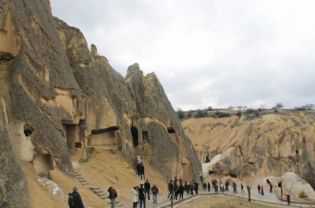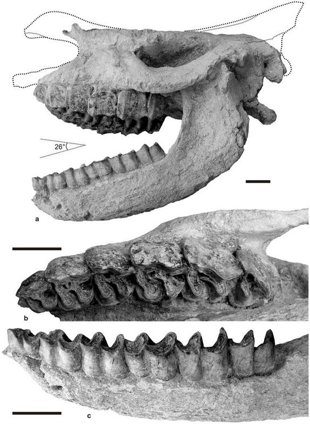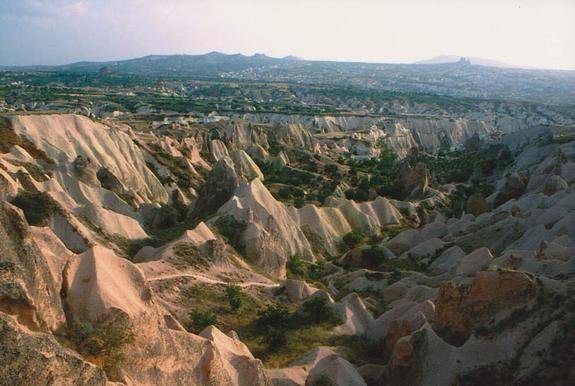Officials in Turkey have announced the discovery of a massive underground city in the historic Cappadocia region of central Anatolia. The complex of carved rooms and tunnels was unearthed as civil workers began excavating for an urban renovation project in 2013, but its discovery was not made public until recently. Experts estimate the still-unnamed find may date as far back as 3,000 B.C., and they have already uncovered many artifacts and hidden rooms along with what may amount to several miles of tunnels—many of them wide enough to drive a car through.
Turkey’s Cappadocia region has long been designated a World Heritage site for its dazzling rock formations and more than 200 underground cities and villages, but according to government officials, a new discovery in Nevşehir Province could be the most extraordinary ancient find to date. The previously unknown subterranean metropolis was discovered by accident during a massive urban renewal project by the Housing Development Administration of Turkey, more commonly known as TOKI. Workers had demolished several hundred buildings and begun prepping for new construction when they stumbled upon a honeycombed network of cave entrances, tunnels and hand carved chambers in the area surrounding a Byzantine-era hilltop castle. The construction project has now been indefinitely postponed, and engineers and researchers have descended on the scene to explore the site’s labyrinthine interior.
“It is not a known underground city,” TOKI President Mehmet Ergün Turan told the Hurriyet Daily News, the English-language Turkish paper that first broke the story. “Tunnel passages of seven kilometers are being discussed. We stopped the construction we were planning to do on these areas when an underground city was discovered.”
Detailed information about the layout or condition of the city has been slow to emerge, but early estimates place the age of some sections at around 5,000 years old. Turkish officials claim they have removed several dozen artifacts from the chambers, and have reported discovering “escape galleries,” tunnels several feet wide and even what appear to have once been hidden places of worship. Nevşehir Province is already home to Derinkuyu, an 18-story underground city that was once capable of housing around 20,000 people, but if early size estimates prove correct, the new site may be even bigger. Nevşehir mayor Hasan Ünver told the Hurriyet Daily News that the complex was so vast that other underground cities in the region would be the size of a “kitchen” if placed within it.

“The underground city [was found] in the 45 hectares of the total 75 hectare area that is within the transformation project,” he said. “We started working in 2012 with the project. We have taken 44 historical objects under preservation. The underground city was discovered when we began the destruction in line with the protocol. The first galleries were spotted in 2013. We applied to the Preservation Board and the area was officially registered.”
Nevşehir and the surrounding Cappadocia region have long been known as the home of what is perhaps the world’s most exquisite collection of underground cities and villages. Several million years ago, intense volcanic activity shrouded the region under several layers of ash. Eons of erosion then whittled the deposits down into a spectacular landscape of conical rock formations and eye-catching spires known as “fairy chimneys.” Since this hardened volcanic rock, or “tuff,” was soft and highly malleable, it proved a natural building material for the region’s ancient residents. Some 3,500 years ago, they began fashioning the hillsides into sprawling subterranean dwellings that featured apartments, stables, temples, ventilation shafts and even tombs. Some subterranean settlements such as Derinkuyu and the massive Kaymakli contained functional freshwater wells and stone doors for protection from invaders. Byzantine-era Christians famously used them as hideouts in the 6th century A.D., when Persians, Arabs and Seljuq Turks threatened the region from several sides. These holy residents left their mark on the cities in the form of religious frescos and underground chapels, many of which remain in good condition to this day.
Just who first built the underground structures and when remains something of a mystery. Archaeologists suspect the Phrygians, Persians or 15th century B.C. Anatolian Hittites may be responsible, but since the caves are carved from natural rock, it is difficult to trace their construction to a specific date. The first written evidence of the mysterious cities is not found until the 5th century B.C. in the Greek writer Xenophon’s “Anabasis,” which states that the region’s houses consisted of “underground structures with an aperture like the mouth of a well by which to enter, but they were broad and spacious below.”
While researchers still know very little about Nevşehir’s newest subterranean city, they have begun to speculate on how it was used. Özcan Çakır, a professor in the Geophysics Engineering department at Çanakkale Onsekiz Mart University near Gallipoli, is one of the experts involved in excavating the new find. He told the Hurriyet Daily News that the complex might have functioned as a space for storing and transporting food and produce. “We believe that people who were engaged in agriculture were using the tunnels to carry agricultural products to the city,” he said. “We also estimate that one of the tunnels passes under Nevşehir and reaches a faraway water source.” A consistent underground climate of around 55 degrees Fahrenheit may have made the cave city an appealing location for preserving food. Even today, Turks in Cappadocia often use ancient underground buildings as storage for fruit and vegetables.
The new city is not the first underground settlement to be discovered by accident in Turkey. The famed subterranean complex at Derinkuyu was only unearthed in 1963, after a man making renovations to his home found a stone passageway behind one of his walls. A similar event took place in August of this year, when an Anatolian man stumbled upon a massive subterranean chamber while cleaning the floors of his house.
- Tags
- Archaeology
- Turkey

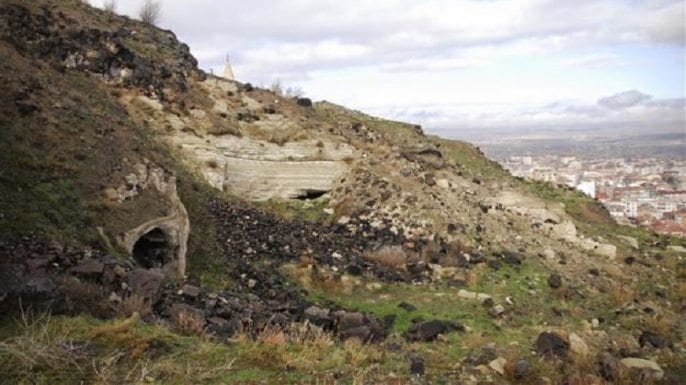

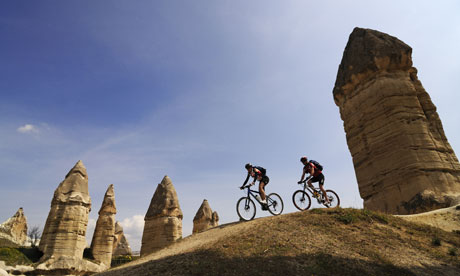
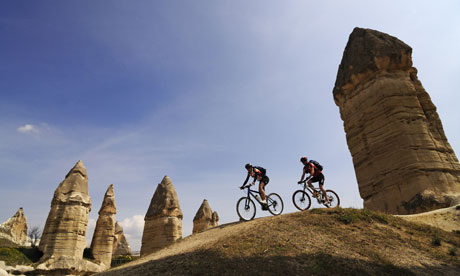
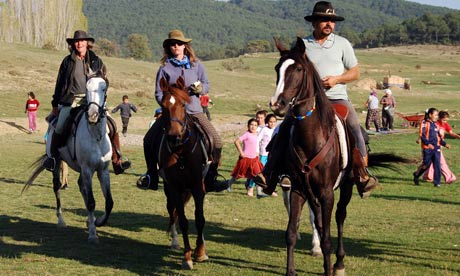 Riding the Evliya Celebi route in Turkey.Remote areas of Turkey’s north-west became accessible when a newhorse riding and hiking trail opened in 2011. It follows part of the pilgrimage route of the celebrated 17th-century traveller and adventurer Evliya Çelebi – who was also a talented dervish, musician and writer. Developed from goat tracks, forestry paths and Roman and Ottoman roads, the trail passes some of the country’s most spectacular landscape, taking in ancient hill forts and villages that are well off the beaten track, as well as beautiful stretches of Lake Iznik. The full route is roughly 650km and takes about 25 days to complete on horseback, but it’s possible to do shorter sections. In October, In the Saddle has a 14-night riding trip starting at the village of Hersek, near Istanbul, and finishing at Kütahya, the ancestral home of Evliya.
Riding the Evliya Celebi route in Turkey.Remote areas of Turkey’s north-west became accessible when a newhorse riding and hiking trail opened in 2011. It follows part of the pilgrimage route of the celebrated 17th-century traveller and adventurer Evliya Çelebi – who was also a talented dervish, musician and writer. Developed from goat tracks, forestry paths and Roman and Ottoman roads, the trail passes some of the country’s most spectacular landscape, taking in ancient hill forts and villages that are well off the beaten track, as well as beautiful stretches of Lake Iznik. The full route is roughly 650km and takes about 25 days to complete on horseback, but it’s possible to do shorter sections. In October, In the Saddle has a 14-night riding trip starting at the village of Hersek, near Istanbul, and finishing at Kütahya, the ancestral home of Evliya.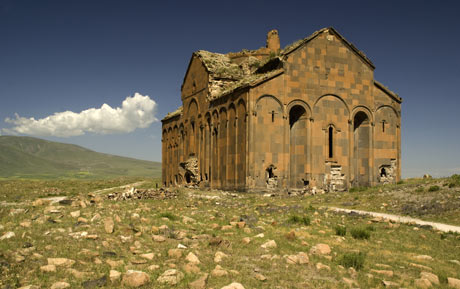 Remains of Great Cathedral at Ani, ruined capital of the Armenian Kingdom, near Kars. Photograph: AlamyThe Dogu Express runs across Turkey from the capital, Ankara, to the city of Kars on the Armenian border, passing through magnificent rugged scenery, most notably along the Euphrates river. It makes a relaxing yet thrilling trip and, complete with couchettes and restaurant car, is a comfortable way to venture to the wild east of the country. One of the highest cities in Turkey, Kars is home to the dramatic remains of a 12th-century castle, and is a convenient gateway for a visit to the striking ruins of Ani, an Armenian medieval city that is now on the Turkish side of the border. Trains leave from Ankara every day at 6pm and arrive at Kars the following day at 6.29pm. Note that for this year and next, Istanbul’s Haydarpasa railway station is closed for engineering works. To reach Ankara from Istanbul, you will instead need to take a bus to Eskisehir, from where a high-speed train connects to the capital.
Remains of Great Cathedral at Ani, ruined capital of the Armenian Kingdom, near Kars. Photograph: AlamyThe Dogu Express runs across Turkey from the capital, Ankara, to the city of Kars on the Armenian border, passing through magnificent rugged scenery, most notably along the Euphrates river. It makes a relaxing yet thrilling trip and, complete with couchettes and restaurant car, is a comfortable way to venture to the wild east of the country. One of the highest cities in Turkey, Kars is home to the dramatic remains of a 12th-century castle, and is a convenient gateway for a visit to the striking ruins of Ani, an Armenian medieval city that is now on the Turkish side of the border. Trains leave from Ankara every day at 6pm and arrive at Kars the following day at 6.29pm. Note that for this year and next, Istanbul’s Haydarpasa railway station is closed for engineering works. To reach Ankara from Istanbul, you will instead need to take a bus to Eskisehir, from where a high-speed train connects to the capital.

